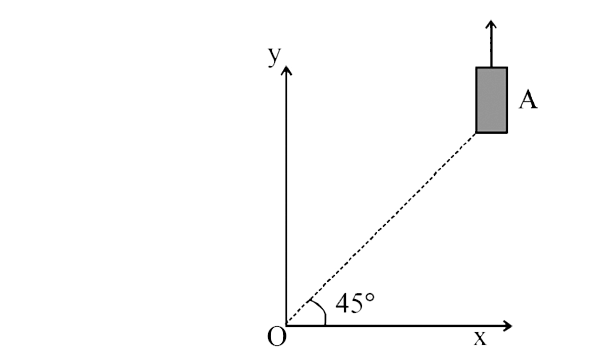A machine which is 75 percent efficient, uses 12 joules of energy in lifting up a 1 kg mass through a certain distance. The mass is then allowed to fall through that distance. The velocity at the end of its fall is (in ms−1)
To solve the problem step by step, we will follow the principles of energy conservation and the definitions of work, potential energy, and kinetic energy.
Step 1: Calculate the Work Done by the Machine
The machine is 75% efficient and uses 12 joules of energy. The work done by the machine can be calculated using the formula:
Work Done=Efficiency×Input Energy
Substituting the values:
Work Done=0.75×12 J=9 J
Step 2: Relate Work Done to Potential Energy
When the mass is lifted, the work done on the mass is converted into gravitational potential energy (PE). The potential energy at height h can be expressed as:
PE=mgh
Where:
- m=1 kg (mass)
- g=9.81 m/s2 (acceleration due to gravity)
- h is the height the mass is lifted.
From Step 1, we know that the work done (which equals the potential energy at height h) is 9 J:
mgh=9 J
Step 3: Solve for Height h
Rearranging the equation for height h:
h=PEmg=9 J1 kg×9.81 m/s2
Calculating h:
h≈99.81≈0.917 m
Step 4: Calculate the Kinetic Energy at the Bottom
When the mass falls back to the original height, all the potential energy converts into kinetic energy (KE) at the bottom:
KE=12mv2
Since all potential energy converts to kinetic energy:
KE=9 J
Step 5: Solve for Velocity v
Setting the kinetic energy equal to 9 J:
12mv2=9
Substituting m=1 kg:
12(1)v2=9
12v2=9
Multiplying both sides by 2:
v2=18
Taking the square root:
v=√18≈4.24 m/s
Final Answer
The velocity at the end of its fall is approximately 4.24 m/s.
---
The machine is 75% efficient and uses 12 joules of energy. The work done by the machine can be calculated using the formula:
Work Done=Efficiency×Input Energy
Substituting the values:
Work Done=0.75×12 J=9 J
When the mass is lifted, the work done on the mass is converted into gravitational potential energy (PE). The potential energy at height h can be expressed as:
PE=mgh
Where:
- m=1 kg (mass)
- g=9.81 m/s2 (acceleration due to gravity)
- h is the height the mass is lifted.
mgh=9 J
Rearranging the equation for height h:
h=PEmg=9 J1 kg×9.81 m/s2
Calculating h:
h≈99.81≈0.917 m
When the mass falls back to the original height, all the potential energy converts into kinetic energy (KE) at the bottom:
KE=12mv2
Since all potential energy converts to kinetic energy:
KE=9 J
Setting the kinetic energy equal to 9 J:
12mv2=9
Substituting m=1 kg:
12(1)v2=9
12v2=9
Multiplying both sides by 2:
v2=18
Taking the square root:
v=√18≈4.24 m/s
The velocity at the end of its fall is approximately 4.24 m/s.
Topper's Solved these Questions
- WORK, ENERGY AND POWERBOOK - DC PANDEY ENGLISHCHAPTER - WORK, ENERGY AND POWEREXERCISE - CHECK POINT 6.1
20 Videos
- WORK, ENERGY AND POWERBOOK - DC PANDEY ENGLISHCHAPTER - WORK, ENERGY AND POWEREXERCISE - CHECK POINT 6.2
20 Videos
- WORK, ENERGY & POWERBOOK - DC PANDEY ENGLISHCHAPTER - WORK, ENERGY & POWEREXERCISE - Level 2 Comprehension Based
2 Videos
- WORK, POWER AND ENERGYBOOK - DC PANDEY ENGLISHCHAPTER - WORK, POWER AND ENERGYEXERCISE - E Integer Type Questions
11 Videos
Similar Questions
A machine, which is 72 percent efficient, uses 36 joules of energy in lifting up 1kg mass through a certain distance. The mass is the allowed to fall through that distance. The velocity at the end of its fall is
View SolutionA metal ball falls through water with terminal velocity 20 ms−1. When the ball is allowed to fall through vacuum, then
View Solution
Knowledge Check
A spherical metal ball of mass m and radius (r) is falling through a viscous medium. The value of its terminal velocity is proportional to
A1/r onlyBm/rC(m/r)1/2Dm onlyA pulley system of velocity ratio 6 is used to lift a load of 250kgf through a vertical height of 30m. Find the distance through which effort is applied.
A18mB1800mC180mD1.8km
On a frictionless horizontal surface , assumed to be the x−y plane , a small trolley A is moving along a straight line parallel to the y−axis ( see figure) with a constant velocity of (√3−1)m/s . At a particular instant , when the line OA makes an angle of 45(∘) with the x− axis , a ball is thrown along the surface from the origin O. Its velocity makes an angle ϕ with the x− axis and it hits the trolley .
(a) The motion of the ball is observed from the frame of the trolley . Calculate the angle θ made by the velocity vector of the ball with the x−axis in this frame .
(b) Find the speed of the ball with respect to the surface , if ϕ=(4θ)/(3).

View SolutionA body freely falling from the rest has velocity v after it falls through a height h the distance it has to fall down for its velocity to become double is
View SolutionA mass of 1kg carrying a charge of 2C is accelerated through a potential of 1V. The velocity acquired by it is
View SolutionAn object of mass 10 kg falls from rest through a vertical distance of 10 m and acquires a velocity of 10ms−1. The work done by the push of air on the object is (g=10ms−2)
View SolutionA cord is wound around the circumference of wheel of radius r. The axis of the wheel is horizontal and MI is I. A weight mg is attached to the end of the cord and falls from rest. After falling through a distance h, the angular velocity of the wheel will be
View SolutionA cylinder of mass m is suspended through two strings wrapped around it as shwon in figure . Find a. the tension T in the string and b. the speed o the cylinder as it falls through a distance h.

View Solution
